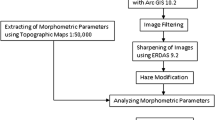Abstract
Pahoehoe toe dimensions, morphology, and branching relationships were analyzed in flows emplaced during 1972 at Mauna Ulu, a satellitic shield on the east rift zone of Kilauea Volcano, Hawai'i. In order to characterize regions within flow fields dominated by networks of pahoehoe toes, measurements of toe length, width, thickness, and orientation were completed for 445 toes at 13 sites. Variations in site characteristics, including slope, substrate, and position in the flow field allow an evaluation of the effects of such parameters on toe dimensions. Toe surface morphology (ropy or smooth), local flow lobe position (interior or margin), and connective relationships between toes were documented in the form of detailed toe maps. These maps show the number of branches connecting a given toe to other toes in its local pahoehoe network and illustrate branching patterns. Statistical analyses of toe dimensions and comparisons of pahoehoe toe study sites and sub-populations combined with field observations, evaluation of toe maps, and qualitative examination of toe dimension size distributions show the following: (a) Although there are significant variations at a given site, toes typically have mean lengths (101 cm) greater than mean widths (74 cm) and mean widths greater than mean thicknesses (19 cm); sites that have mean widths greater than mean lengths are those with lower slopes. (b) Where significant site-to-site variations in mean values of a given toe dimension were apparent, these differences could not be directly related to site characteristics. (c) Ropy toes have significantly larger mean values of length, width, and number of branches than smooth toes, and toes with three or more branches have greater lengths, widths, and thicknesses than toes with two or fewer branches, suggesting concentration of flow in these toe types. (d) The skewness of all size distributions of toe length and width to larger values suggests that toes are transitional to larger sheets and channels, consistent with field observations; and (e) Two distinct types of branching patterns (called monolayer and centrally ridged) were observed in preserved pahoehoe flow lobes. The significant variability in measured toe dimensions at Mauna Ulu suggests that toe dimensions are influenced by numerous locally defined, random factors, and that an approach based on stochastic methods can be used to model pahoehoe flow emplacement.
Similar content being viewed by others
Author information
Authors and Affiliations
Additional information
Received: 19 January 1998 / Accepted: 24 March 1999
Rights and permissions
About this article
Cite this article
Crown, D., Baloga, S. Pahoehoe toe dimensions, morphology, and branching relationships at Mauna Ulu, Kilauea Volcano, Hawai'i. Bull Volcanol 61, 288–305 (1999). https://doi.org/10.1007/s004450050298
Issue Date:
DOI: https://doi.org/10.1007/s004450050298




